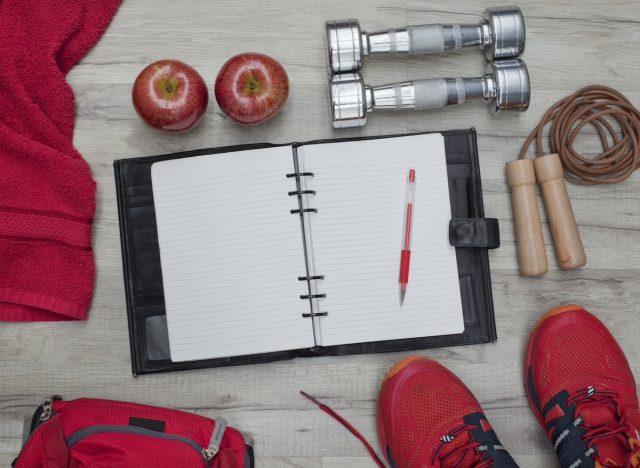How Many Pushups Do You Need to Do to See Results?

Whether you do 100 daily pushups or are looking to do more of this classic bodyweight exercise, you may be wondering just how many pushups you need to do to see results.
Pushups are a staple movement that can help strengthen and tone your upper-body muscles, including your chest, shoulders, and triceps. However, the number of pushups you should do to see noticeable results can vary depending on several factors, including your fitness level, goals, and workout routine.
The good news is understanding these factors can help you determine the right approach to incorporate pushups into your fitness regimen. That's why we chatted with Mike Masi, CPT, a certified personal trainer at Garage Gym Reviews, who shares his expert insights to help you determine your ideal amount of pushups to achieve your health and fitness goals.
Pushups offer plenty of benefits beyond just building muscular strength. They can also help improve core strength, cardiovascular fitness, and muscular endurance. Additionally, a 2019 study found that the amount of pushups you can do is associated with heart health. Participants who could perform more than 40 pushups had a substantially lower cardiovascular disease risk than those who could complete less than 10 pushups.
So, if you're ready to elevate your pushup game to the next level, keep reading to learn how. Then, be sure to check out these 5 Floor Workouts To Slim Down Your 'Dad Bod' For Good.
The benefits of pushups:

As detailed above, pushups offer many benefits beyond building muscle and upper-body strength. These benefits include increased core strength and cardiovascular fitness. Plus, pushups can be done practically anywhere without any equipment, making them a convenient choice for most people looking to boost their fitness.
"Pushups are a versatile bodyweight exercise that targets multiple muscle groups and offers numerous benefits," says Masi. "These include strength building of the upper body, increased muscle growth in the chest, arms, and shoulders, improved core stability, and enhanced cardiovascular health. Also, pushups don't require equipment and can be scaled easily to fit most fitness levels."
Set realistic pushup goals.

Like any other health or fitness goal, setting realistic goals around your pushup count is crucial for making progress and staying motivated. Masi gives the following tips for goal setting:
- Assess your current fitness level. Determine how many pushups you can do in a row with proper form. This will be your starting point and a good way to gauge your progress.
- Identify desired outcomes. Whether it's building strength, size, or endurance, your goal will dictate the nature of your pushup routine.
- Make incremental goals. If you can do 10 pushups now, try to do more as you get stronger. Remember, you might improve quickly at first, but progress could slow down the more you exercise over time.
- Adopt a balanced approach. Make sure your workout plan includes enough rest and good food to get the best results and avoid getting hurt.
The ideal amount of pushups for building strength and muscle:

Your ideal amount of pushups varies depending on your fitness goals. However, Masi has a valuable strategy for increasing your reps.
"If working toward your first pushup, you will have to improve your upper-body strength significantly," he says. "This can be achieved by scaling the exercise intensity using a surface height for your hands higher than the floor. You can start lowering the surface once you can do 10 reps in a row without losing form."
Masi adds that you may have to scale the exercise up or down for an appropriate stimulus. For example, if you can do five pushups, you may want to elevate the surface, and if you can do 50 reps, you may want to add a band around your back for some external resistance.
Ultimately, your goal should be to come close to failure with each set, then rest for a couple of minutes before trying again. Repeat three to five times.
As for how often you should perform pushups, Masi says, "Aim to include pushup exercises in your routine three times a week. This approach allows for muscle recovery and growth between sessions. If you do them more frequently, aim for less volume each session, or try not to go too close to failure with each set."
Track your progress.

You can't improve what you don't track. If you want to see results from your pushups, consider keeping a workout journal or using a fitness app to monitor the number of pushups you can do in a set amount of time. Then, as you get stronger and fitter, you can adjust your routine by increasing the number of reps or sets accordingly.
Masi offers up the following advice for tracking your progress along your pushup journey:
- Keep a workout journal. Record the number of pushups, sets, and any variations you perform each session. Note any improvements in form or increases in volume.
- Listen to your body. Pay attention to signs of overtraining or fatigue. Adequate rest and recovery are vital for muscle growth and injury prevention.
- Incorporate pushup variations. As your strength increases, add variations like eccentric (lowering phase) focused pushups, changing your hand position (wide or narrow), or increasing the range of motion by putting your hands on blocks.
- Seek professional feedback. To see the most results from pushups, consider working with a fitness professional to ensure your form is correct and to receive personalized advice on advancing your pushup routine.









